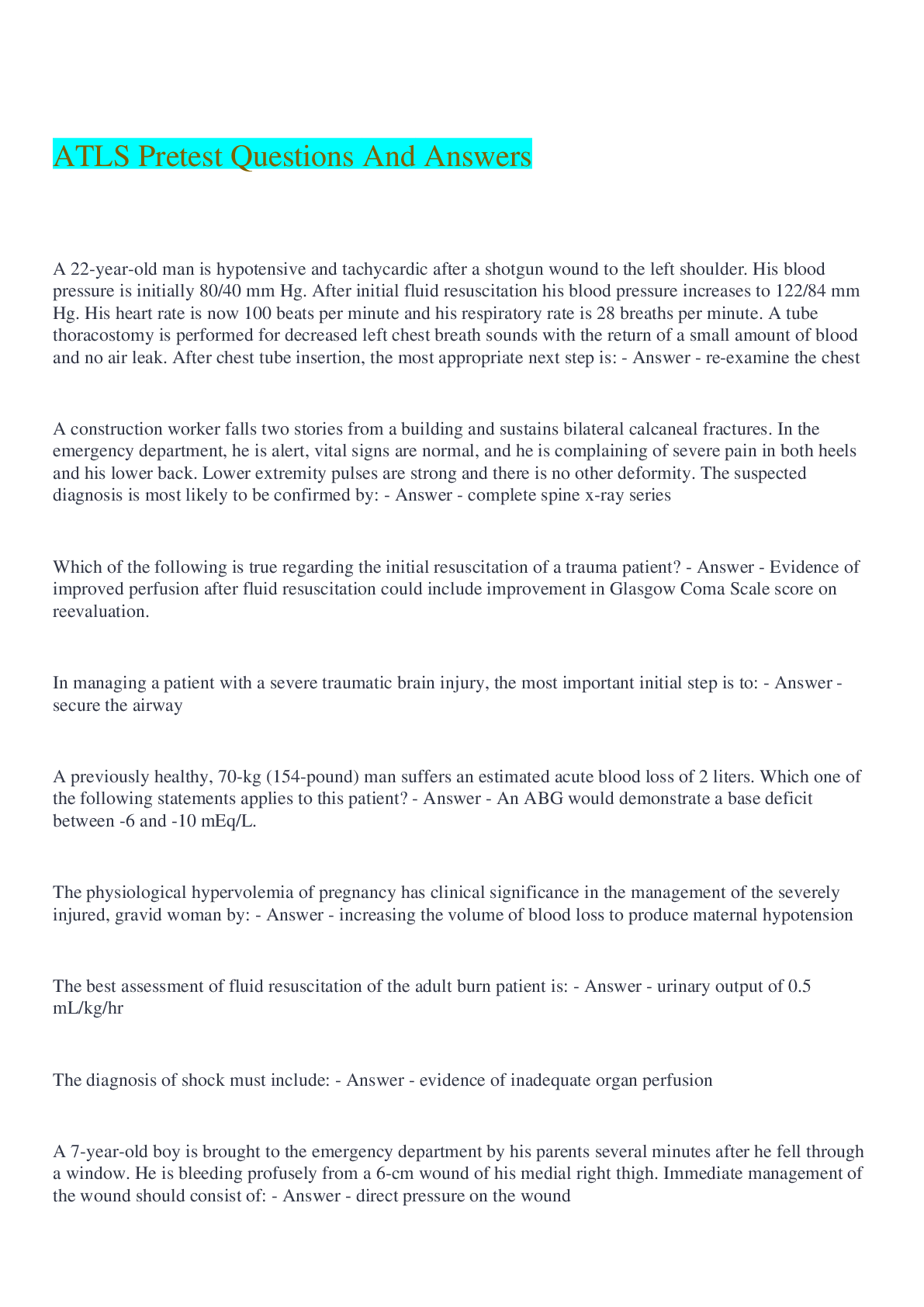*NURSING > Advanced Trauma Life Support (ATLS) > ATLS10 2019/2020 Post-Test. ATLS10 exam 40 Questions and Answers with All CORRECT ANSWERS OUTLINED P (All)
ATLS10 2019/2020 Post-Test. ATLS10 exam 40 Questions and Answers with All CORRECT ANSWERS OUTLINED PASS YOUR EXAM CLEAN
Document Content and Description Below
1. A 24-year-old male pedestrian, struck by an automobile, is admitted to the emergency department 1 hour after in jury. His blood pressure is 80/60 mmHg, heart rate 140 beats per minute and respirato... ry rate is 36 per minute. He is lethargic. Oxygen is delivered via face mask, and two large-caliber IVs are initiated. Arterial blood gases are obtained. His PaO2 is 118 mmHg (15.7 kPa), PaCO2 is 30 mmHg (4.0 kPa), and pH is7.21. The treatment of his acid-base disorder is best accomplished by: a. Hyperventilation b. Restoration of normal perfusion c. Initiation of low-dose dopamine d. Administration of sodium bicarbonate e. Initiation of phenylepinephrine infusion 2. The highest priority in managing a patient whose injuries include closed extremity fractures is: a. Assesing limb perfusion b. Preventing necrosis of the skin c. Decompressing compartment syndrome d. Addressing respiratory insufficiencyIdentifying crush syndrome 3. A 34-year-old female is involved in a motor vehicle crash is brought to the emergency department. Sheis talking, but her voice is hoarse and on exposure she has diagonal bruising of the chest and anterior neck. What is the next step? a. Direct laryngoscopy to exclude laryngeal trauma b. Oxygen by non-rebreathing mask c. Protecting the spine by making her lie down d. Palpation of the anterior neck e. Attaching a pulse oximeter to her finger 4. A 30-year-old male sustains a gunshot wound to the right lower chest, midway between the nipple and the costal margin. He is brought by ambulance to a hospital that has full surgical capabilities. In the emergency department he is endotracheally intubated, fluid resuscitation is initiated through two large-caliber IV lines, and aclosed tube thoracostomy is performed, with the return of 200 ml of blood. A chest xray reveals correct placement of the chest tube and a small residual hemothorax. His blodd pressure is now 70/0 mmHg, and his heart rate is 140 beats per minute. His hypotension is mostlikely due to: a. Tension pneumothorax b. Massive hemothorax c. Pericardial tamponade d. Intraabdominal bleeding e. Insufficient isotonic crystalloid infusion 5. A 20-year-old athlete is involved in a motorcycle crash after having ridden for hours on a very hot day.When he arrives in the emergency department, he shouts that he cannot move his legs. On physical examination, there are no abnormalities of the chest, abdomen, or pelvis. The patient has no sensation in his legs and cannot move them, but his arms are moving. The patient’s respiratory rate is 22, heart rate is 88, and blood pressure is 80/60 mmHg. He is pale and sweaty. What is the most likelycause of his hypotension? a. Neurogenic shock b. Cardiac tamponade c. Myocardial contusion d. Hyperthermia e. Hemorrhagic shock 6. Comapred with adults, children have: a. A longer, wider, funnel-shaped airway b. A less pliable, calcified skeleton c. Greater mobility of mediastinal structures d. A relatively smaller head and larger jaw e. Anterior displacement of C5 on C6 7. Which one of the findings below requires a definitive airway in trauma patients? a. Facial lacerations b. Repeated vomiting c. Partial thickness facial burns, cough, and hoarseness d. Sternal fracture e. Glascow Coma Scale score of 128. In a patient with spinal cord injury, sacral sparing: a. Refers to a fracure of the sacrum b. Is part of the spinal shock syndrome c. Is a good prognostic sign d. Indicates a complete spinal cord injury e. Occurs only with complete transection of the lumbosacral spinal cord 9. A 22-year-old woman falls whil skiing. She is evaluated at a small community hospital that does not have neurological services. Spinal motion is restricted, supplemental oxygen by mask is administered,and two antecubital IVs are placed. Her Glascow Coma Scale score is 12, pupils are equal, blood pressure is 135/76 mmHg, heart rate is 105, and respiratory rate is 19. Chest x-ray is normal. This patient’s management priorities are: a. Repeat primary survey and transfer to a trauma center b. Definitive airway, CT of the head, and intracranial pressure monitor c. IV mannitol, definitive airway, CT of the head, and neurosurgery consult d. CT of the head, EEG, cerebral perfusion pressure monitoring, and hypertonic saline e. IV Dilantin, IV mannitol, mild hyperventilation, and serial arterial blood gases 10. A young male patient is brought to the emergency department following a 5-meter (16-foot) fall froma roof. He responds to pressure by pushing away your hand, opening his eyes, and verbalizing inappropriate words. Pupils are equal. The most important step is management of this patient wouldbe: a. Immidiate intubation to protect his airway b. Administer 25 mg/kg IV bolus mannitol c. Insert two large-bore IVs d. Alcohol and drug screening e. Determine whether amnesia is present and, if so, for what period of time 11. Twenty-seven patients are seriously injured in an airplane crash at a local airport. The principles oftriage include: a. Establish a triage site whthin the hot zone of the crash site b. Treat only the most severely injured patients first c. Immidiately transport all patients to the nearest hospitald. Treat the greatest number of patients in the shortest period of time e. Produce the greatest number of survivors based on available resources 12. A 35-year-old female falls down a flight of stairs. She has extensive bruising of her face and head. Herheart rate is 120, blood pressure 90/70 mmHg, and respiratory rate is 26. The patient`s condition is most readily explained by: a. Associated head injury b. Hypovolemia from hemorrhagic shock c. Alcohol intoxication d. Spinal shock from cervical spine injury e. Neurogenic shock from cervical spine injury 13. Which one of the following statements is correct: a. Cerebral contusions may coalesce to form an intracerebral hematoma b. Epidural hematomas are usually seen in the frontal region c. Subdural hematomas are caused by injury to the middle meningeal artery d. Subdural hematomas typically have a lenticular shape on CT scan e. The associated brain damage is more severe in epidural hematomas 14. An 18-year-old is brought to the emergency department after having been shot. He has one bullet wound just below the right clavicle and another just below the costal margin in the right posterior axillary line. His blood pressure is 110/60 mmHg, heart rate is 90 beats per minute, and respiratory rate is 34 breaths per minute. After ensuring a patent airway and inserting two large-caliber IV lines,the next appropriate step is to: a. Obtain a portable chest x-ray b. Administer a bolus of additional IV fluid c. Perform a laparotomy d. Obtain an abdominal CT scan e. Perform diagnostic peritoneal lavage 15. Which one of the following statements is true concerning cranial anatomy related to traumatic injury? a. A scalp laceration is an unlikely source of bleeding in a patient with a long transport time. b. The meninges are comprised of the dure, pia, and arachnoid. c. The middle meningeal artery lies between the dura and pia mater. d. Effacement or shift of the ventricles occurs commonly with concussions.e. A dilated pupil is produced when the sympathetic nerve fibers located on the third cranialnerve are compressed by the temporal lobe. 16. A 47-year-old house painter is brought to the hospital after falling 6 meters (20 feet) from a ladder andlanding straddling a fence. Examination of his perineum reveals extensive ecchymosis. There is blood in the external urethral meatus. The initial diagnostic study for evaluation of the urinary tract in this patent should be: a. Cystoscopy b. Cystography c. Intravenous pyelography d. CT scan e. Retrograde urethrography 17. Which of the following statements is true? a. The laryngeal mask airway is an infraglottic device. b. The multilumen esophageal airway occludes the supraglottic lumen and ventilates throughthe port placed distal to the vocal cords. c. The nasopharyngeal airway is an ideal supraglottic device for patients with cribiform platefractures. d. Nasotracheal tubes position a cuffed airway in the infraglottic space. e. Tracheostomy tubes are placed in apneic, hypoxic patients in the supraglottic space. 18. Neurogenic shock has all of the following characteristics except which? a. Hypotension b. Vasodilation c. Bradycardia d. Neurologic deficit e. Narrowed pulse pressure 19. Which one of the following statements concerning spinal cord trauma is true? a. A normal lateral c-spine film excludes injury. b. A vertebral fracture or dislocation is unlikely in the absence of physical findings of spinal cordinjury. c. A patient should remain on a long board until injury is excluded radiographycally. d. Diaphragmatic breathing in an unconscious patient whi has fallen mayindicate cervical spinalcord injury. e. Determination of wether a spinal cord lesion is complete or incomplete must be made in theprimary survey. 20. Which one of the following statements is false concerning Rh isoimmunization in pregnant traumapatient? a. It occurs in blunt penetrating abdominal trauma b. It is produced by minor degree of fetomaternal hemorrhage c. Rh immuniglobulin therapy should be administered to pregnant females who have sustaineda gunshot wound to the leg d. Isoimmunization is not a problem in Rh-positive pregnant patients e. Initiation of Rh immunoglobulin therapy does not require proof of fetomaternal hemorrhage 21. An 18-year-old motorcyclist collides head-on with a pick-up truck and sustains massive facial injuries.In the emergency department his blood pressure is 150/88 mmHg, heart rate is 88 beats per minute and regular, and respiratory rate is 26 breaths per minute. His respirations are labored and sonorous.His Glascow Coma Scale score is 7. Attempts at orotracheal intubation with restricition of cervical spinal motion are unsuccessful due to bleeding and distorted anatomy. The patient becomes apneic. The best procedure for airway management in this situation is: a. Nasotracheal intubation b. Emergency tracheostomy c. Surgical cricothyroidotomy d. Placement of an oropharyngeal airway e. Placement of an nasopharyngeal airway 22. A 25-year-old male is brought to the hospital after sustaining partial- and fullthickness burns involving60% of his body surface area. General surgical services are available. His right arm and hand are severely burned. There are obvious fullthickness burns of the entire right hand and a circumferential burn of the right arm. Pulses are absent at the right wrist and are not detected by Doppler examination. Management should include: a. Fasciotomy b. Angiography c. Escharotomy d. HeparinizationTangential excision 23. A 30-year-old male presents following a motor vehicle crash. Vital signs are respiratory rate 18, heartrate 88, blood pressure 130/72 mmHg, and Glascow Coma Scale score 13. Laparotomy is indicated when: a. There is a distinct seat-belt sign over the abdomen b. The CT scan demonstrates a grade 4 hepatic injury c. There is evidence of residual hemothorax after chest tube placement d. CT demonstrates retroperitoneal air e. CT demonstrates a retroperitoneal hematoma 24. All of the following are signs of aortic rupture on chest x-ray of a patient who sustained a bluntdecelerating traume except which one? a. Mediastinal emphysema b. Presence of a pleural cap c. Obliteration of the aortic knob d. Deviation of the trachea to the right e. Depression of the left mainstem bronchus 25. A 30-year-old female is brought to the hospital after a fall from her bicycle. She was initially unconscious and then regained co [Show More]
Last updated: 1 year ago
Preview 1 out of 11 pages

Also available in bundle (1)

ATLS EXAM QUESTIONS BUNDLE
Are you revising for ATLS 10 exam? This bundle is for you to test your knowledge. The questions are based from the ATLS Advanced Trauma Life Support tenth (10th) edition Student Course Manual.
By STUDY-GUIDENOTES 2 years ago
$20
10
Reviews( 0 )
Document information
Connected school, study & course
About the document
Uploaded On
Nov 11, 2021
Number of pages
11
Written in
Additional information
This document has been written for:
Uploaded
Nov 11, 2021
Downloads
1
Views
337



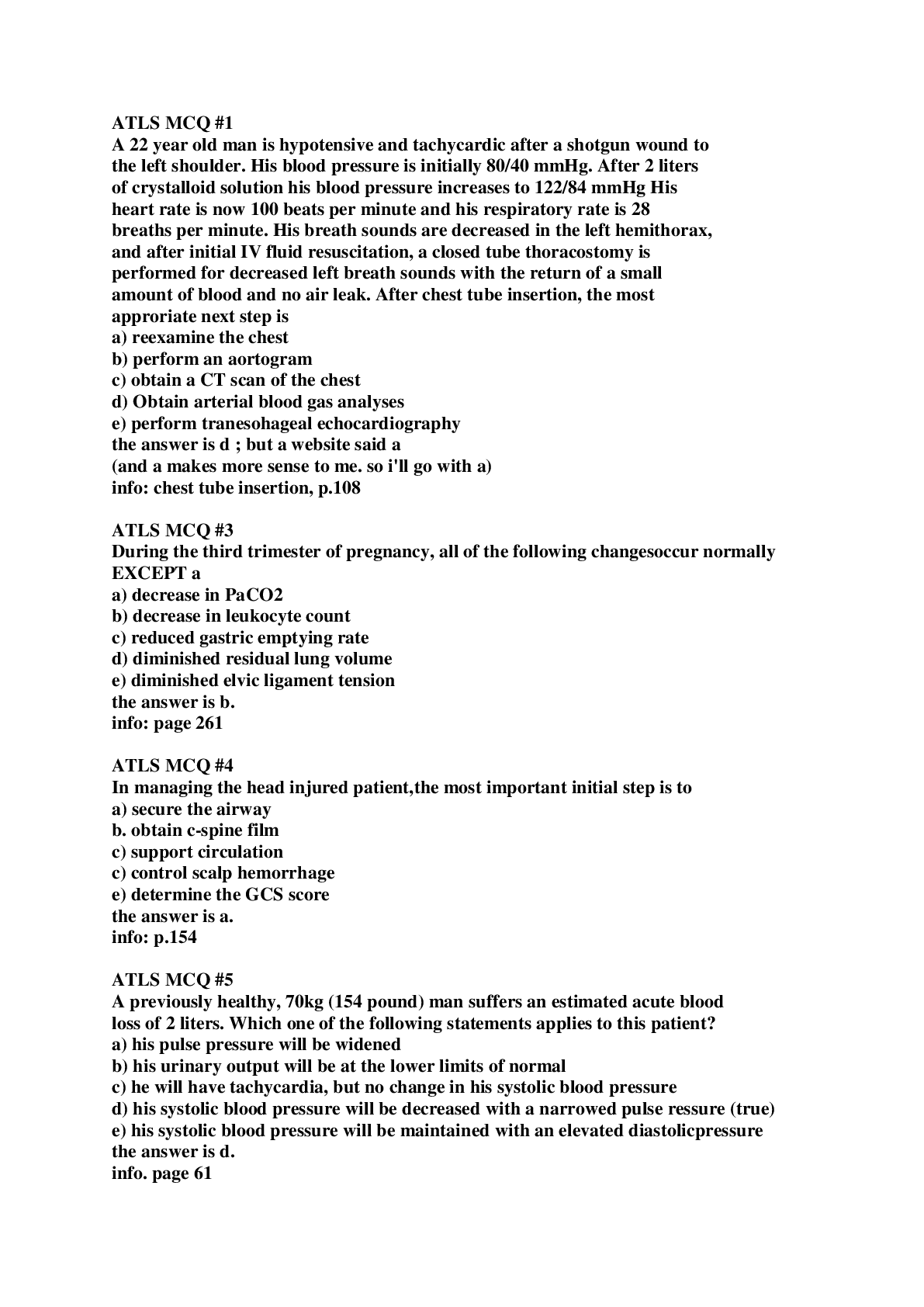

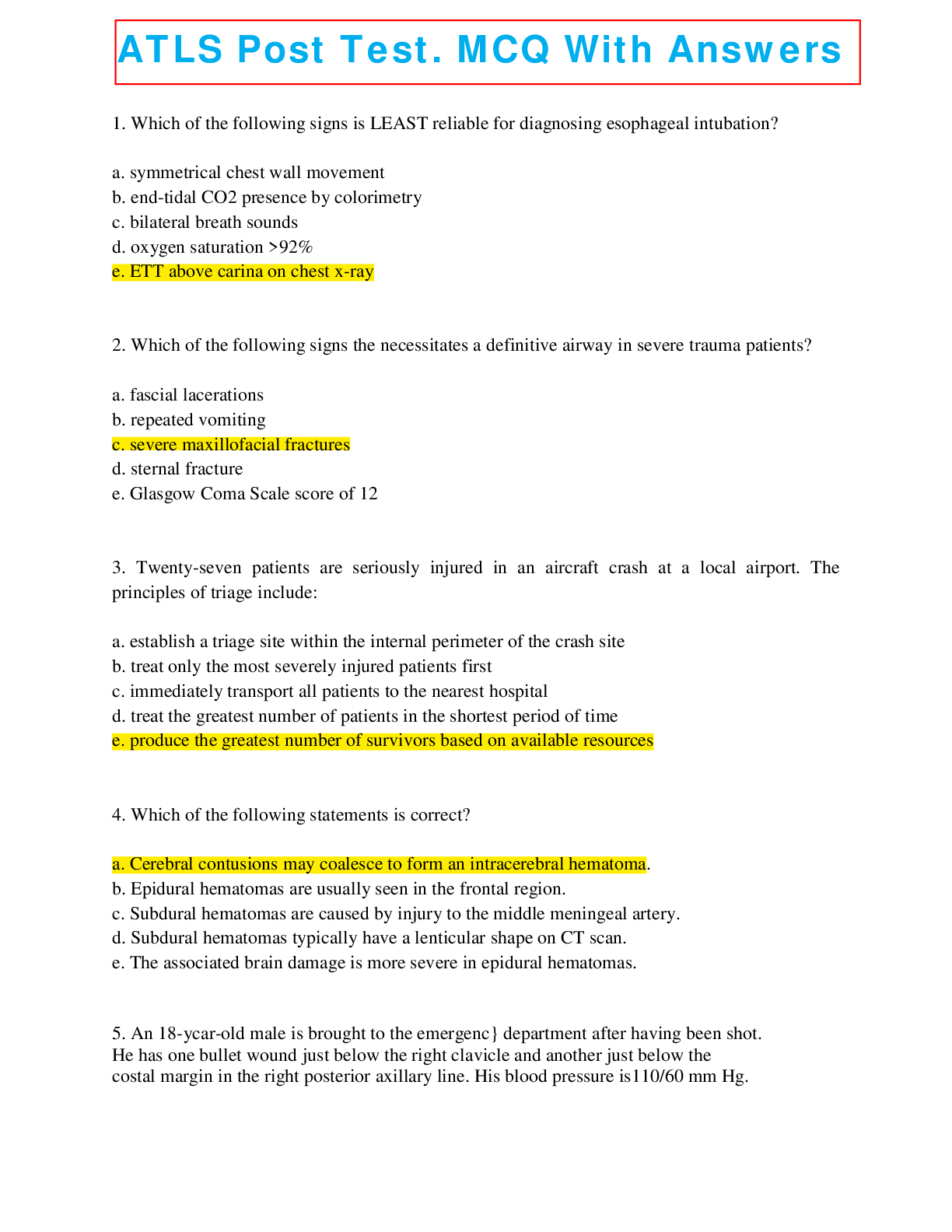
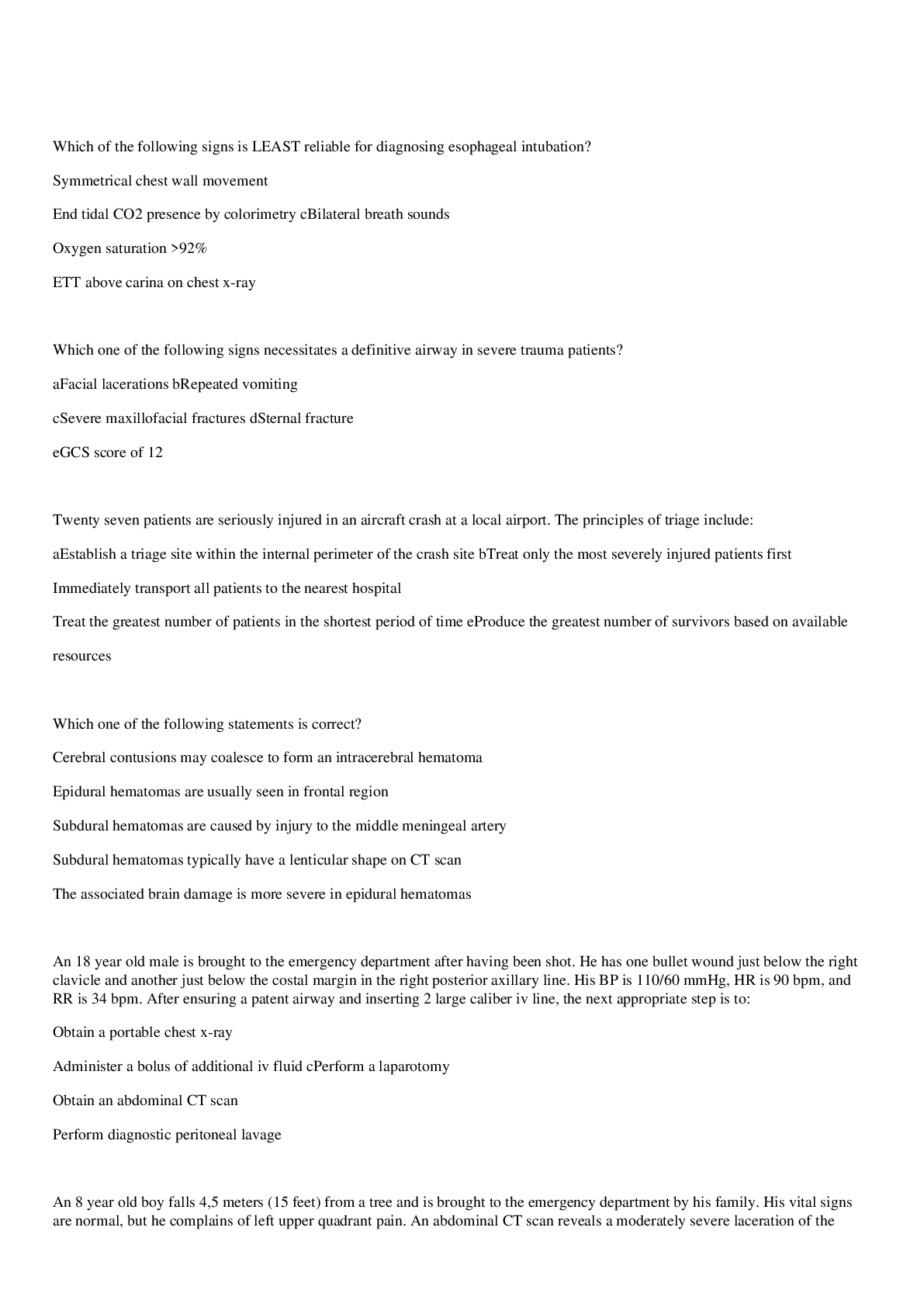
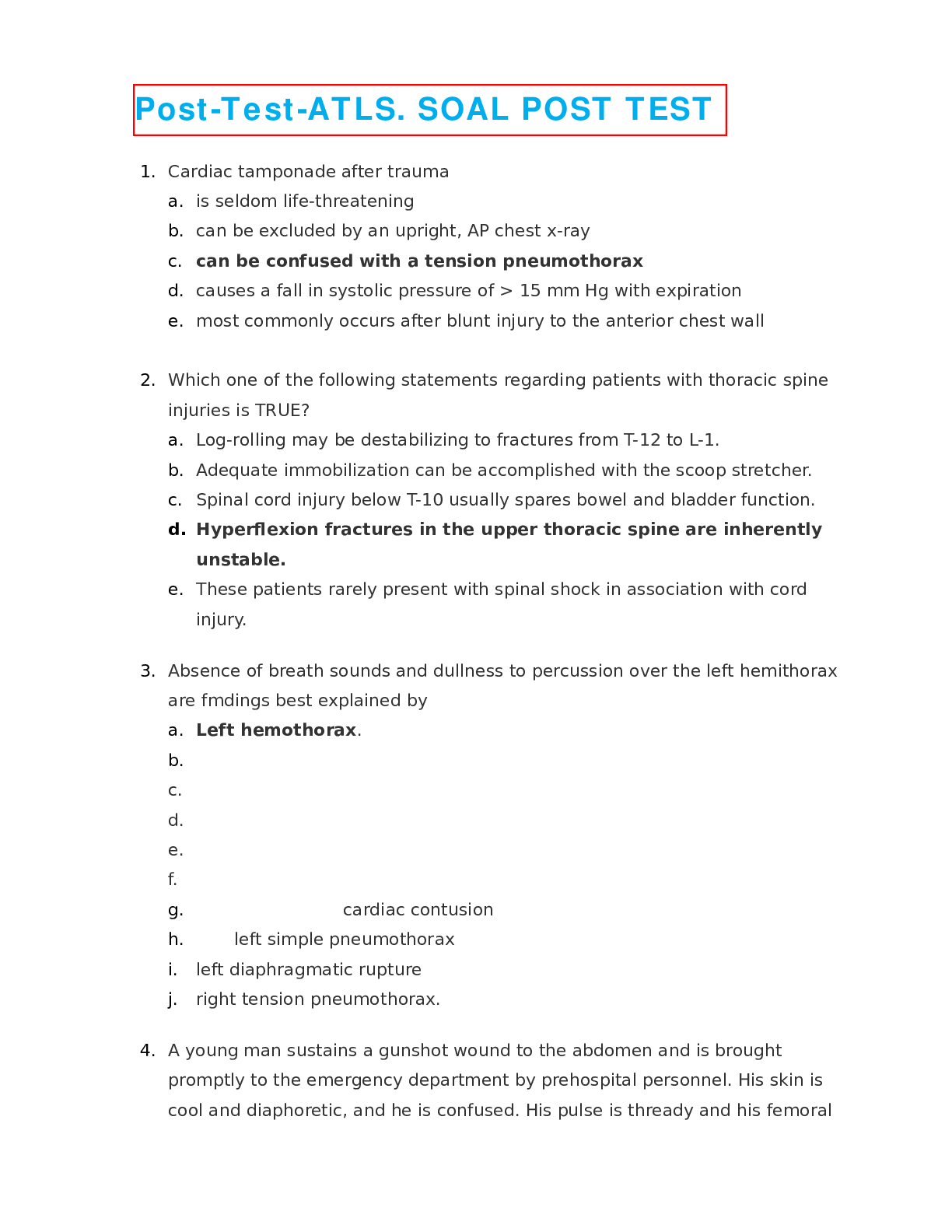
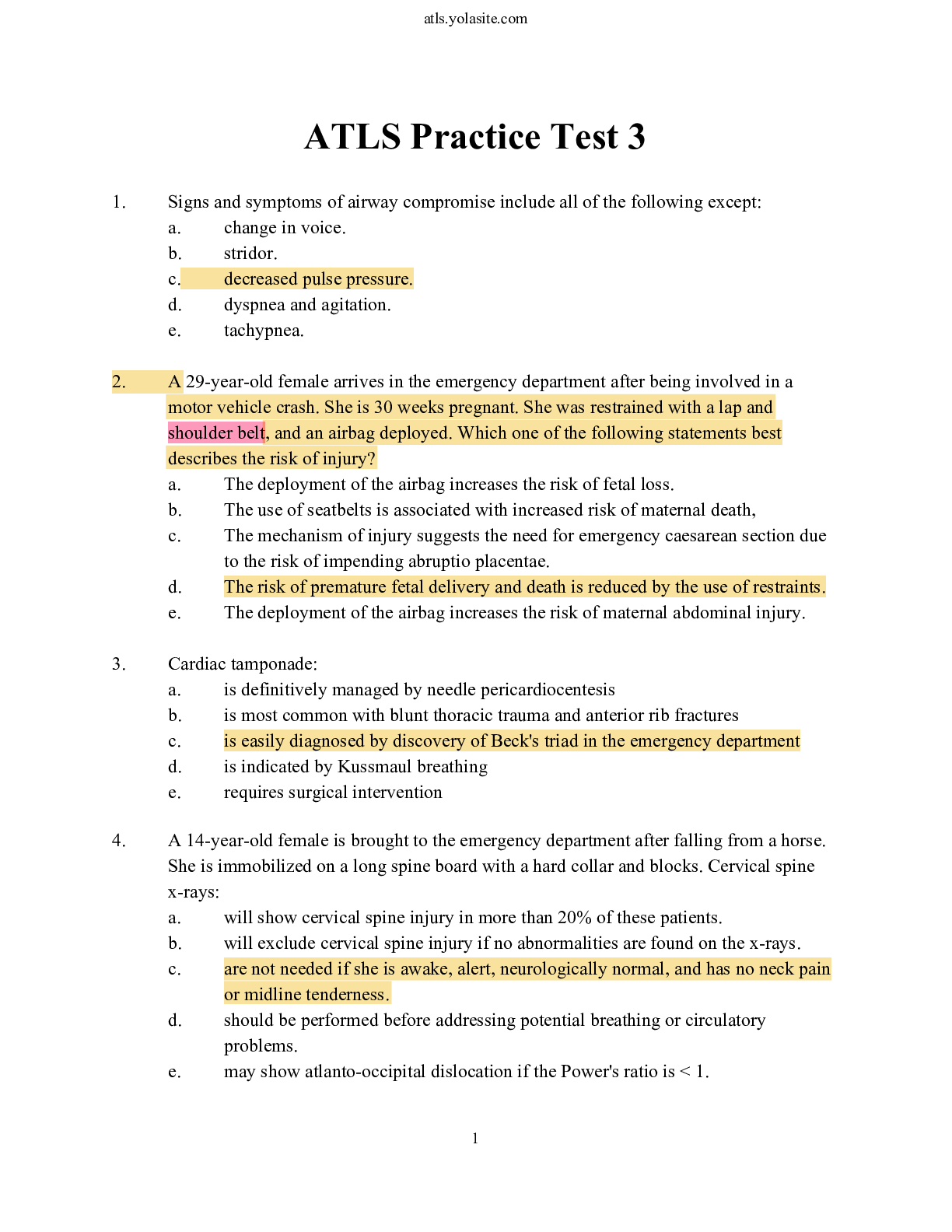
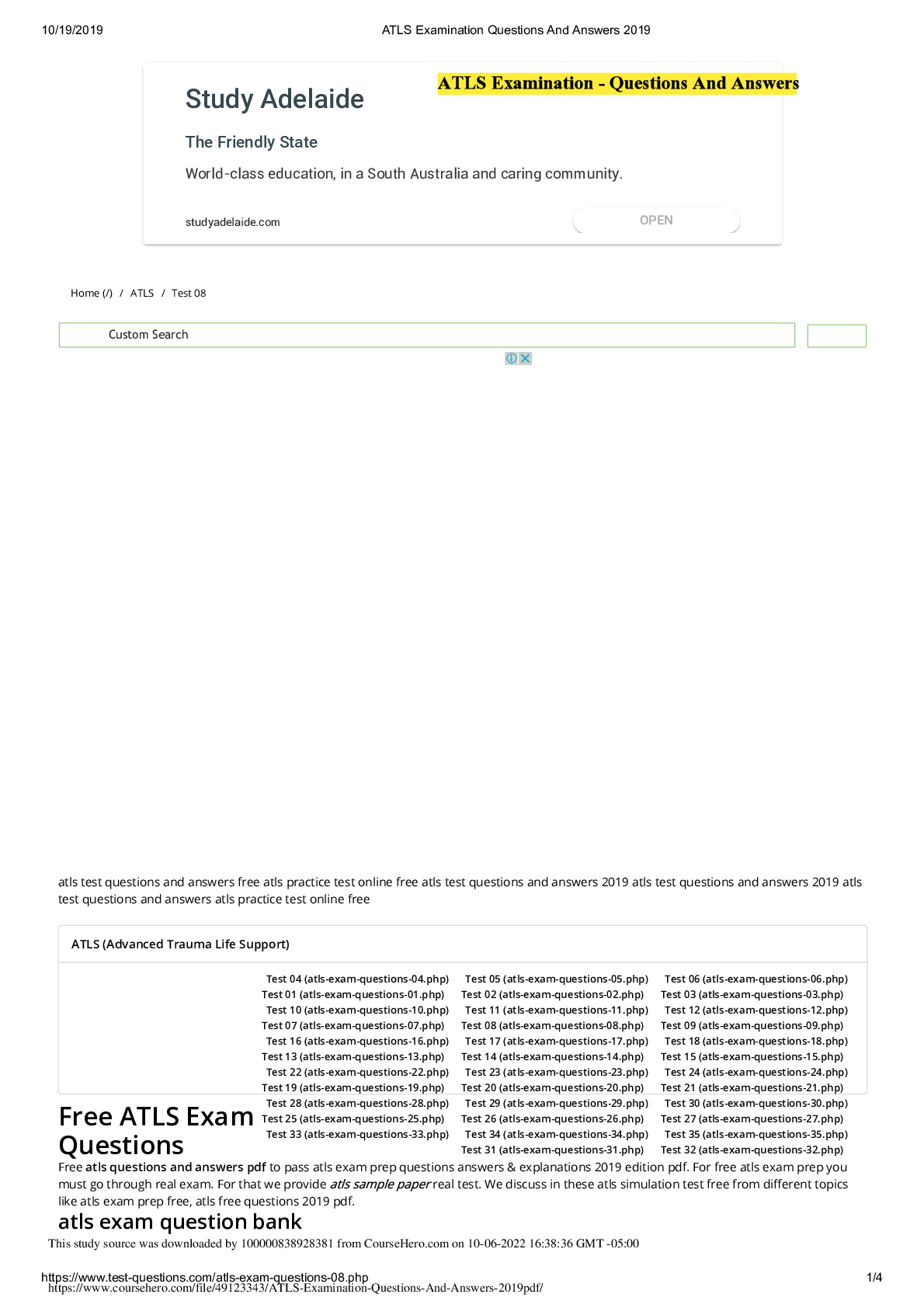


.png)

